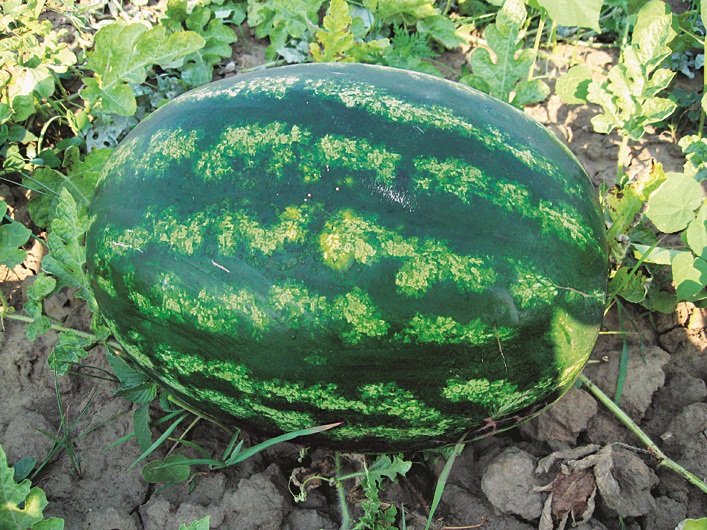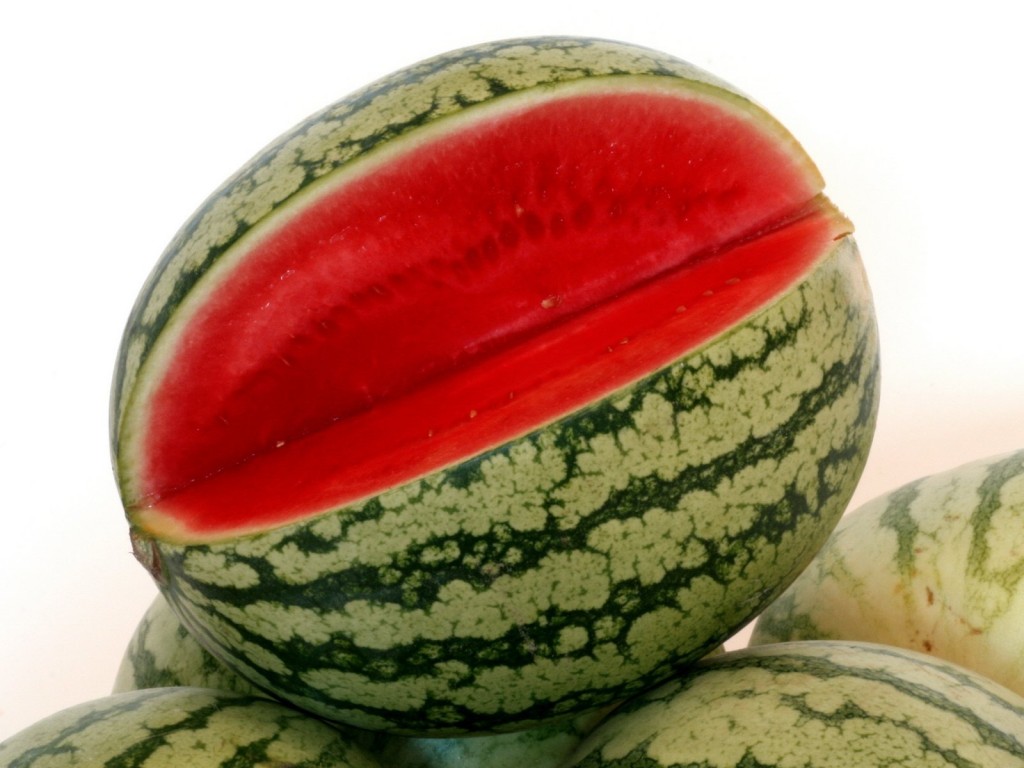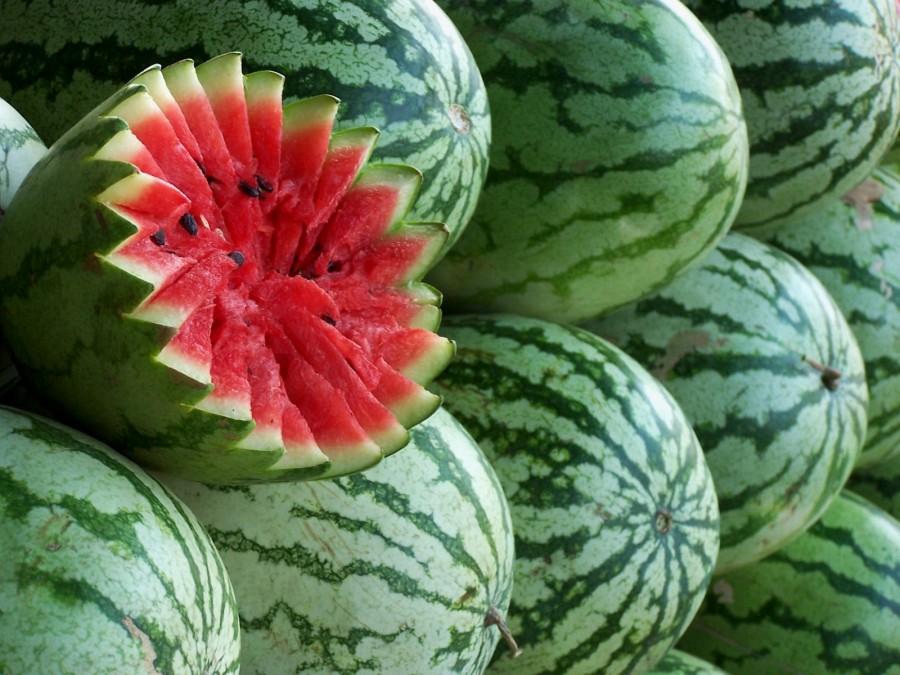Astrakhan watermelon: description and features of the variety
Content
Description of the variety
The famous Astrakhan watermelon as a separate variety was bred in 1977 by the efforts of K.E. Dyutin. This is a classic spherical or slightly oblong watermelon. The pulp of ripe fruits is bright red, juicy, aromatic, coarse-grained with a characteristic rather sweet taste. During dry periods, voids may appear in the fruits, which do not have any effect on the palatability.
The peel is smooth with a pattern of alternating dark and light green thorny stripes. Watermelon of this class must be thick-chinned. Average fruit weight is about 8 - 10 kg. In terms of ripening, it belongs to the medium early - from the moment of seed germination, it ripens for 70 - 85 days. Differs in resistance to most diseases characteristic of melons and gourds, convenient and unpretentious in cultivation. It is characterized by high yields, excellent transportability and shelf life - they can be stored for up to two and a half months.
What is the harm and benefit
Ripe watermelon is a unique dietary product that has practically no contraindications for regular use. In fact, 80% of its fruit consists of water, and the rest of the volume contains vegetable fiber, fructose, a small amount of glucose and sucrose, as well as trace elements.Watermelon is characterized by a pronounced diuretic effect, so its pulp is very useful for those suffering from diseases of the joints, heart and blood vessels. Fructose is absorbed in the human body without the cost of insulin, which means that even patients with insulin-dependent diabetes mellitus can eat a sweet-tasting fruit.
The striped juicy fruits are just a storehouse of such a trace element as magnesium. With chronic deficiency, blood pressure rises. It also promotes the binding of oxalates, which prevents the formation of kidney stones, and plays an important role in the processes of bile secretion and in the deactivation of cholesterol. In addition, magnesium is involved in the normalization of intestinal motility, helps relieve muscle spasms and reduces nervous irritability.
In 100 grams of watermelon pulp, the content of this microelement, which is extremely important for human health, is as much as 224 milligrams. Only almonds can boast of its greater concentration. To satisfy the body's daily need for magnesium, it is enough to enjoy only 150 grams of ripe and tasty fruit.
This representative is rich in melons and potassium. True, its content is lower than in dried apricots, persimmons and bananas, loved by adherents of many diets. Although if we also consider the calorie content, then when drinking watermelon, the body will receive three times less calories than a banana.
However, it should be noted that watermelon is not useful for everyone and not always.It should not be eaten by those suffering from diarrhea and intestinal upset. It is also contraindicated for those prone to edema. Diabetics should also be careful with this delicacy, given its high glycemic index.
In addition, the harm from watermelon can be due to the use of certain chemicals in the cultivation. Most often they are nitrates. Their use contributes to the rapid growth and high weight of the fruit. But at the same time, such substances are stored in the pulp and enter the human body with it, causing either acute poisoning or chronic intoxication due to gradual accumulation.
Video "Watermelons in the middle lane"
Growing features
If until recently the combination of the words "cultivation" and "watermelon" presupposed a hot southern climate, today work on adaptation and acclimatization of its varieties and the emergence of new hybrids make it possible to grow striped fruits even in Western Siberia, albeit only in greenhouses.
In the southern regions of Russia, the Astrakhan variety is grown by planting seeds in open ground. But in the regions of the middle zone and in the suburbs, the seedling method is used. At the same time, 4 - 5 weeks before planting on the site, the seeds are kept for a day in a solution of manganese and zinc to protect future sprouts from diseases. Then they are wrapped with cotton cloth or tissue paper and placed in water, where they are set aside at a temperature of about +28 ° C until sprouts appear.
After that, they are planted in separate containers filled with peat. When the plants get 3 - 4 leaves, you can start planting seedlings. At the same time, a week before planting, the frequency of watering and the temperature are gradually reduced. The main requirements for their cultivation in the regions of the middle lane are air warmed up to +21 - 29 ° С, a sunny place and no weeds.
It should be noted that watermelons are quite sensitive to their predecessors and do not like to grow after pumpkin, melon, cucumber or cabbage. But they treat planting after peas, potatoes, beans or corn quite well. Seedlings are planted in light-textured soil in holes up to 8 cm deep at a distance of about a meter. As representatives of melons, watermelons do not tolerate acidic soils.
Since they require a lot of heat, the soil between the plants should be covered with a 4 - 5 cm layer of mulch, which increases the temperature of the soil by almost 10 ° C and does not allow it to dry out. Also, during the period of active growth, plants should be fed with potassium-phosphorus mixtures and nitrogen.
The technology of growing watermelons involves weeding, loosening the soil and moderate watering. The remains of vegetation after the weeding made are immediately removed from the site. Being drought tolerant plants, watermelons are at the same time quite responsive to irrigation. During the period of growth of the main stem and leaves, they need increased watering. After the beginning of fruiting, it is cut to speed up the ripening of the fruit.
The main pests that can harm watermelon plantings are spider mites, aphids and wireworms. For the prevention and control of them, the most common means is spraying with an infusion of garlic or ash. Such processing should be stopped one month before the start of the harvest. Plants heavily infested with pests must be removed from the site and burned.
What you need to know
The Astrakhan watermelon begins to ripen not earlier than August and its harvest reaches its peak closer to September. Everything that appears on the shelves before that time, although it may be grown in the Astrakhan region, but early maturing Dutch watermelons, and even often with the use of chemistry. Therefore, the fruit should be carefully examined before purchasing. If a small, slightly rotten area with a dot in the center is found, this is a sure sign that saltpeter was injected with a syringe to accelerate growth.
In order to distinguish a ripe good watermelon from a bad one when choosing, one should focus on a number of characteristic features. The surface of the fruit should not have a matte coating and a glare should be clearly visible on reflection of sunlight. The yellow spot on the watermelon or the so-called "patch" is where the fruit comes into contact with the ground during growth. If it is small, then it matured on its own in comfortable conditions. A large patch is a sign of a lack of sunlight and heat, such a fruit will be watery and not sweet enough to taste.
The stem or "tail" of a good watermelon is dried and yellowish. If it has completely dried out, then the fruit has been stored torn off for a rather long period. If the tail is completely removed, then the seller is hiding something and it is better not to take this copy. Also, a ripe watermelon hums when patted, and crackles when squeezed with hands.
Video "Growing varieties of watermelon"
There are many varieties of watermelon, and being able to properly grow a particular variety is not an easy task. This video will help you figure out all the nuances.





